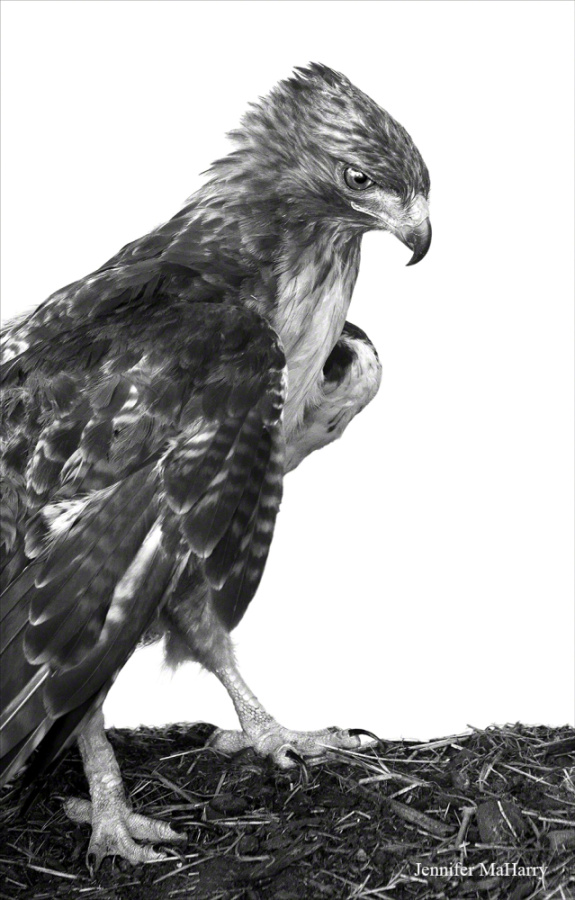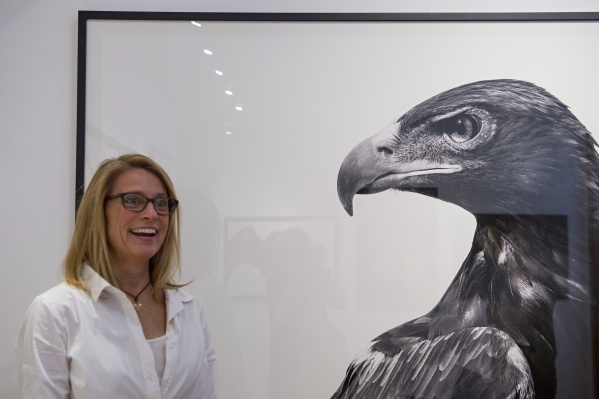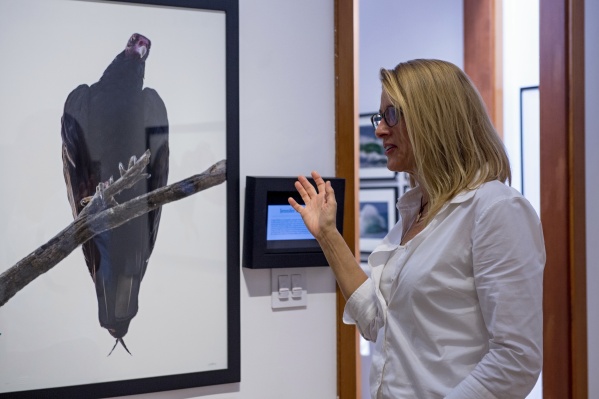Captured with serious, bold and unflinching poses, the new exhibit “Nature LA: Birds of Prey” running into Jan. 5, 2014 at the G2 Gallery in Venice showcases Southland feathered flappers from the lens of Culver City-based photographer Jennifer MaHarry. These are the not the happy chirpers helping Cinderella that you’d see in a typical Disney movie; no these are raptors, serious and unflinching, thoughtful and daunting, birds that make you instantly realize how close genetically they are to their dinosaur ancestors.

MaHarry is best known for her poignant and intimate images of wild horses; she’s a long-time advocate against the government sanctioned roundups of wild mustangs and burros, events which, she says, allows for many organizations to buy these magnificent creatures and profit from their slaughter.
MaHarry’s current exhibition, however, features the beauty and power of local birds of prey; and it all came together by missed opportunities, an afternoon of 100+ temperatures, and perched turkey vultures eyeing her in the Arizona wilderness.
Earlier in the year, MaHarry had made arrangements to photograph a wild horse and burro roundup in Nevada; but unlike other times where she was allowed in to snap and capture images, BLM officials there denied all photographers from the event. “Everyone was hopping mad,” she recalls wondering how she could salvage this trip with some images. (MaHarry’s day job is a graphic designer working in the motion picture marketing arena.) She knew of a natural horse habitat in Arizona and thought, ‘Maybe I can find some,’” and booked a quick flight there.
So MaHarry was in the starkness of Arizona on an incredible hot afternoon. She didn’t find as many horses as she had hoped; but she was the object of interest from a group of turkey vultures that watched her from high above a rocky perch. “I watched them for a long time,” she says. “I saw how curious and social there were with each other and when I came back and read up on vultures. I was fascinated with them.”
MaHarry took that fascination to a broader scope and decided that if she couldn’t photograph horses, maybe another critter was calling to her camera. She contacted officials at local wildlife rescues – the Ojai Raptor Center and the California Wildlife Center – to see if she could photograph any birds of prey there. For months, she visited the centers to snap rehabilitated birds, many that would soon be released back to the wild.
Setting up a simple giant scrim as a backdrop, MaHarry found personalities of each of the birds of prey she photographed. The kestrel was skittish, the great horned owl was intimidating (“I read his talons, when clenched, exhibits 4,000 pounds per square inch of bone-crushing power”) and the screech owls were overwhelming adorable (“I had to keep hands in the photo so you could see how small they really are.”)

Cute-factor aside, these birds of prey impressed MaHarry with their wild and powerful nature. “I wanted to capture a soulful look from them, something that expressed who they are, these beings completely covered with the most beautiful feathers. No fighter pilot can achieve the natural agility and speed these birds possess without blacking out from the extreme G forces that the birds are able to endure.”
Among the portraits of local raptors – red tailed hawk, merlin, barn owl, short eared owl and more – at the exhibit, MaHarry’s image of the Arizona turkey vulture hangs as a testimony to her photographic journey.

Also, a raven is present, and while not necessarily a bird of prey, a bird that MaHarry wanted to include because of its intense intelligence.

MaHarry says she will continue to photograph wild horses and be a voice against their destruction, but this side road down the path of local raptors was a welcomed diversion. “I’d love people to realize that not all birds are cute little songbirds,” she says. “The world these birds live in is fierce. They are fighting every day for their survival. They are amazing creatures, worthy of our awe.”
— Brenda Rees, editor

